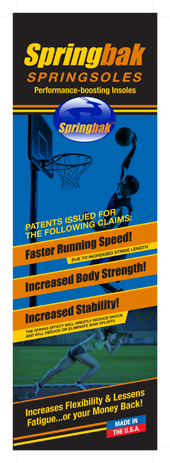Archive for August, 2010
Springbak Speed Training Skills – How To Quicken Your Stride Frequency For More Speed
Posted by: | CommentsSpeed is perhaps the most coveted component of athletic performance. Whether you are a football player looking to better your 40 yard dash times or a marathoner who’s looking to improve your distance time, the importance of foot speed in running is unquestionable.
Our patented Springbak Springsoles will accomplish both increased stride frequency and increases stride length.
Traditional thinking dictates that to be fast, choose your parents carefully. In other words, speed is a genetic trait. While this is true to the extent that it is not possible to be a world-class sprinter without genetic endowment, sport science and proper coaching have done much to refute this.
Speed is a learnable skill that can be taught through motor-learning principles. Ultimately, it is only through the practice (repetition) of these motor skills and proper training that any genetic endowment can reach its highest potential.
There is an old axiom: “I hear, I forget; I see, I understand; I do, I remember.” The more you do something, the better you become at it.
Speed Made Simple to understand:
Although the actual physical components of running speed are rather complex, we’re going to keep things simple. Speed is produced by stride length (distance covered with each stride) and stride frequency (leg turnover time, or how quickly you can get your feet on and off the ground).
Of these two components, stride length is the easiest to develop and is also the most misunderstood. Stride length is not created by how far you can reach forward with each step, but rather by the amount of force you apply to the ground (with the foot striking directly under the hip) and driving back. Our Springbak Springsoles will increase the force you apply to the ground, thus a longer stride length.
Speed is created through the ground, not the air. Once the foot touches the ground, it drives rearward, creating a springboard effect that propels the body forward. Most people are slower than they should be because they pull out of their stride length too early, not allowing the foot to remain on the ground long enough to drive the leg completely straight behind the body, thereby maximizing the force and distance necessary to propel the body farther forward.
Let’s quickly look at two basic mechanical principles that should be considered for proper running form:
Step 1: Keep Your Head Steady:
Head position is critical in athletic performance. Your head should be still during sprinting. We use the term “focus” to mean your eyes should be straight ahead, as if you’re looking at somebody your height in the eyes. Remember, you go where your head goes.
If your head is moving side-to-side, your body is going to be subject to lateral forces that negate from the objective: moving straight ahead. You should run relaxed; you’ll hear track coaches say “Jaw down, shoulders down.” The human head generally weighs between 11 and 14 pounds. Keep this “bowling ball” (your head) in the proper postural alignment: centered between the shoulders.
Step 2: Keep Your Arms Fixed at a 90-degree Angle:
Why? To use the strong muscles of the shoulder girdle to create optimum force. Never run with tight, clenched fists. This will tighten you up and slow you down. Keep your thumb and forefinger in contacts or run with an open palm, whichever you are most comfortable with. Your elbows should be squeezed in to the sides of the body.
Try this: Stand up and put your left hand on your left hip. Move your right arm across your body. Did you notice how your left hip moved? The body is a system of levers and, to simplify matters, what you do with one arm will affect the opposite leg. If your arms cross in the mid-line of your body when running, your hips will rotate in, thereby taking away from your force output and creating rotational forces that minimize your speed.
Enjoy the speed training tips!
Mark Vona – GM Springbak Inc.
_______________
For more tips and information from Springbak:
Visit the Official Springbak® Website at www.springbak.net
Peak Performance Springsoles / Insoles – Run Faster, Jump Higher, Lessen Fatigue
Find us on Facebook: www.facebook.com/springbak
Follow us on Twitter: www.twitter.com/springbak
Friend us on MySpace: www.myspace.com/springbak
Tune in on YouTube: www.youtube.com/springbakinc
Springbak Training Tips: How To Prevent Injury and Improve Performance
Posted by: | Comments Athletes, especially athletes who play sports which require changes of direction and landing from explosive jumps (soccer, basketball, track and volleyball), must train to prevent injury first, and build to improving one’s performance.
Athletes, especially athletes who play sports which require changes of direction and landing from explosive jumps (soccer, basketball, track and volleyball), must train to prevent injury first, and build to improving one’s performance.
Today’s athlete needs to train the lower body for strength and balance and train the core muscles. “Core Training” is a popular buzz-word in the fitness industry and it means different things to different people; however, training the core musculature – the muscles of the abdominal, lower back, hips, pelvis, quadriceps and hamstrings – improve overall strength. For instance, a boxer throws a punch, he used his upper body; however, his power comes from his lower body. The core is the region that transfers the power from the legs through the upper body. With a weak core, the boxers punch lacks power. The same is true of almost every athletic move… just think about that one.
World class athletes, coaches and trainers use Springbak Springsoles in their athletic programs for performance and injury protection. The Springsoles provide you a competitive edge and absorb shock as well. The Springsoles will increase your stride length when you run, and increase your stride frequency (shorten foot plant time) as well as give your game much more balance and stability: What people are saying about Springbak Springsoles.
How can I increase my vertical jump?
We get this question all the time, here’s how:
The best exercises for increasing your vertical jump are squats, lunges and step-ups. These are the best because they are compound movements, which work the knee joint and the hip joint at the same time…Squats are the best exercise an athlete can do for strength if it is performed correctly.
Great tips on lunges:
Lunges are another great body exercise. Once the athlete learns the movement pattern of lunges in different directions-front, backward and side lunges, they can then use weights in the hands for a more intense workout and challenge your neuromuscular system. Also, the athlete can add different elements to the lunge. A simple addition to work the shoulders to use the medicine ball to do a lunge and press. Additionally, a lunge and reach is a good exercise.
Please comment, as we welcome your tips and advice as well.
_____
For more tips and information from Springbak:
Visit the Official Springbak® Website at www.springbak.net
Peak Performance Springsoles / Insoles – Run Faster, Jump Higher, Lessen Fatigue
Find us on Facebook: www.facebook.com/springbak
Follow us on Twitter: www.twitter.com/springbak
Friend us on MySpace: www.myspace.com/springbak
Tune in on YouTube: www.youtube.com/springbakinc






















